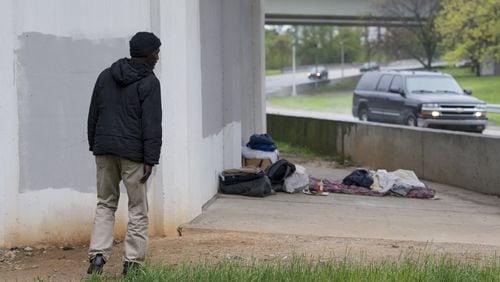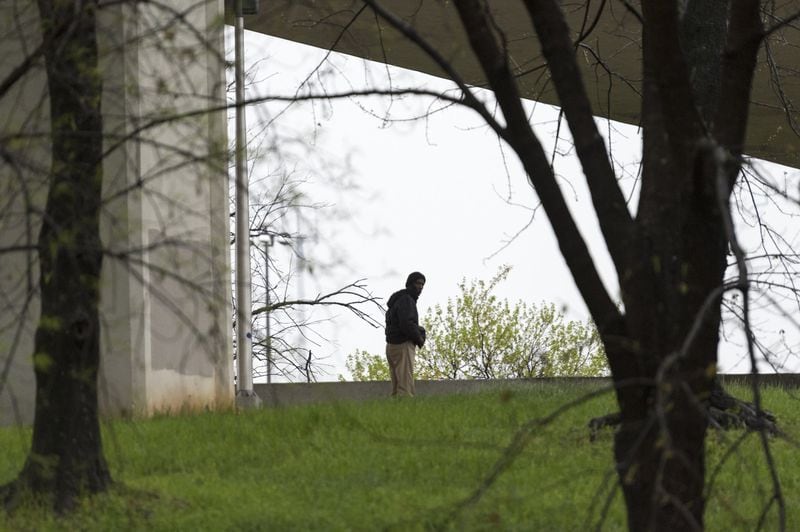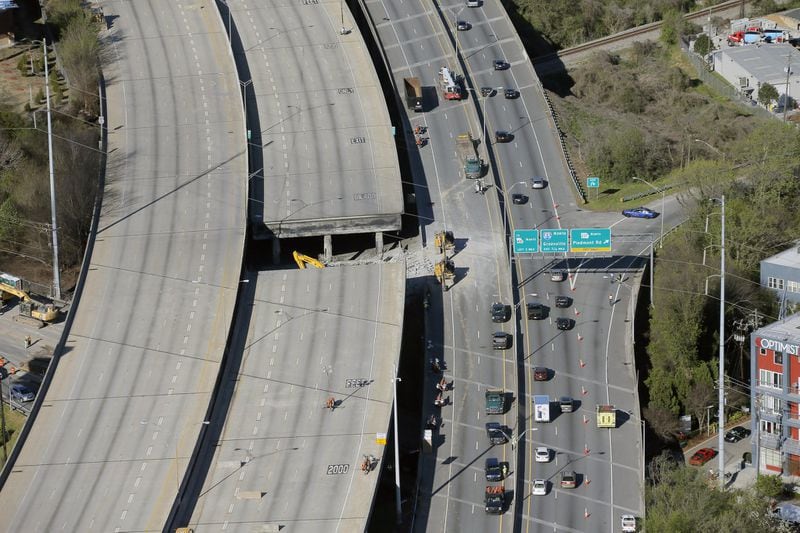David Hill feels safe sleeping under the bridge where the Downtown Connector intersects with Interstate 20. At 59, he says he has lived there for two years.
Other homeless men and women dwell in that same encampment near the heart of Atlanta’s government district, and Hill describes them as a family of sorts. Hundreds of thousands of people pass these camps every day and scarcely notice them. But perhaps they’re noticing now.
Last week, just a few miles to the north of where Hill stands, a fire brought down an elevated section of I-85 near Piedmont Road. Basil Eleby, 39, who is believed to have stayed around the area for years, is charged with arson in the blaze. Authorities allege that he and two companions were there last Thursday, talking about smoking crack, shortly before the fire began beneath the bridge.
On this day, David Hill and others are gathered under their bridge downtown as a violent storm sweeps through Atlanta.
The rain is nothing, he said.
“We have already gotten through the bad part,” said Hill, resting beneath a giant pillar underneath the bridge that has been his home for the past two years.
Unlike others who eschew the bridges, Hill embraces them. A guard rail protects him from cars and trucks flying by, sometimes at 70 mph. There is a light above his camp. Yet the camp is virtually invisible to anybody not in a car.
“I have been through the shelters with the mice and the bedbugs,” Hill said. “I don’t want that. As long as I have enough blankets out here, I will be warm and safe.”
Hill points to nearby camps that, from a distance, look like piles of trash. About 40 yards away, at the next pillar over from Hill’s, a woman wrapped head-to-toe leans against the column.
“She’s just ‘sleep,” Hill said of the woman. “This is the quiet time.”
Credit: Bob Andres
Credit: Bob Andres
‘It’s nasty and cold. Rats are down there’
Barnell Smith avoids the bridges, preferring the Atlanta Union Mission’s shelter.
“I have had to sleep under a bridge about four times,” said Smith, who has been homeless about six months since his aunt kicked him out of her Decatur home because he had no job and no money to earn his keep.
“It is nasty and cold,” he said, waiting with about a dozen other men outside the Union Mission on Monday. “People (urinate and defecate) there, then sleep in lice-infected … blankets. Rats are down there and people spit on you.
“If I was faced with that choice again, I would find a car to sleep in or go back to Detroit and beg my family to take me back in. People under the bridges are treated like they have diseases.”
Homeless people seeking refuge under bridges is not new, however. They have been doing it for years.
Housing advocates in Atlanta suggest that the city’s bridges and overpasses may shelter whole communities.
“Hundreds, maybe thousands, of people live under them,” said Anita Beaty, who runs the Metro Atlanta Task Force for the Homeless. “People live where they have to live when they can’t afford a place to stay. This is just another acknowledgment to the need for housing. It is appalling.”
Beaty questioned the arson charge against Eleby, echoing concerns that are bubbling up on social media in Atlanta.
“Homeless people are the ready victims in any situation. There is no mystery that there have been homeless people for years living under that overpass,” she said. “I don’t think (the Eleby case) is clear at all. It is a fairly railroaded decision to arrest him on some really serious arson charges based on the evidence I have seen.”
‘There are entire mini-cities’
Bridge overpasses also offer places to hide while using drugs.
“There are (homeless) encampments where there are entire mini-cities,” said Anna Foote, deputy director of Hope Atlanta, which finds housing and provides services for the homeless in 29 counties.
“There are fewer unsheltered homeless (people) in downtown Atlanta today than (in recent years),” she said. “But the sense is there’s just as many as there ever was.”
According to the Department of Housing and Urban Development's 2016 Annual Homeless Assessment Report to Congress, homelessness in Georgia declined 6.4 percent from 2015 to 2016 to 9,265. That was almost 35 percent fewer people than in 2010.
Georgia State University sociology professor Deidre Oakley said some of that decline can attributed to programs that focus on veterans.
“We still have a terrible homeless population,” Oakley said, however. “It’s not just the city of Atlanta. It’s the entire Atlanta metro area.”
Yet private funding sources are giving less, leaving programs more dependent on public dollars — which are also being cut.
‘They just move to another location’
The state and local governments have addressed the problem, in some cases, by moving the homeless out of sight. They also are evicting those who have set up camps and bulldozed the area to ensure they won’t come back.
In Gainesville last fall, for example, officials cleared out an encampment under Queen City Bridge; some say it was the oldest homeless camp in the Gainesville area.
In Atlanta, local law enforcement and health officials have occasionally cleared out spaces beneath bridges, as well as open camps, of homeless people.
“They (homeless people) just move to another location (until) they think the heat has died down,” said Marshall Rancifer, who says his crack cocaine addiction led to his being homeless for two years.
“Most people don’t have any clue of what’s going on in this city,” said Rancifer, who is no longer homeless but has since formed his own outreach organization, taking food and supplies to homeless encampments almost daily.
There are many reasons for homelessness, experts say. Veterans suffering PTSD find themselves with nowhere to go. Those with drug or alcohol addictions lose touch with family. People can't find jobs and then can't pay rent. About 30 percent of the homeless population is mentally ill.
An overpass and a dictionary
Beneath a bridge that spans Ivan Allen Boulevard, a man swears he is not homeless, although his pallet and shopping cart tell a different story.
He is sitting, his knees supporting a giant dictionary that he is plowing through.
He regally declines to give his name – his heavy English accent suggests that he is not from these parts – as he takes off his glasses and closes his dictionary.
The rain has done little to wash away the stench of urine under the bridge.
“I will be going back to England soon to finish a movie that I am starring in,” he says. “Now I must take a nap.”









